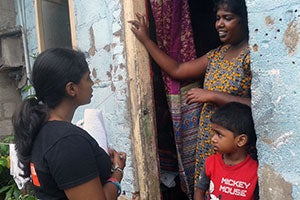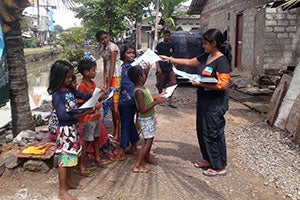In the words of Chamathya Fernando: In Sri Lanka, MDG results are a mixed bag for women and girls
Date:
As the UN discusses the new development agenda that will be adopted beyond the Millennium Development Goals (MDGs) target date of 2015, 20-year-old youth activist Chamathya Fernando with the Sri Lanka Girl Guides Association talks about how these goals have impacted the lives of women and girls in an urban low-income settlement. Fernando spoke at a panel on the MDGs at the Stakeholders Forum on 5 December, 2013.

I am the National Coordinator of the “Stop the Violence, I speak out for girls’ rights” Campaign for the Sri Lanka Girl Guides Association, a member organization of the World Association of Girl Guides and Girl Scouts (WAGGGS). On 1 December 2013, my team and I visited one of the urban low-income settlements in Colombo, the capital city of Sri Lanka on a field visit to interview residents, specifically women and children, about their living conditions, children’s education, health and hygiene, sanitary facilities, food and nourishment and other issues they face in their day-to-day life.
We constructed a questionnaire covering all aspects of the MDGs and along with my team members, I interviewed women and children of different ages. We found that little progress had been made towards MDG goal 1, on extreme poverty and hunger due to lack of decent employment. It was one of the major issues that women faced in the area as their income was not enough to give their children three meals per day. We found that the majority of women work as domestic help. Many men were unemployed and some were addicted to drugs.
We also asked the women whether they face any discrimination, harassment or violence. We found that there has been an increase in domestic violence due to the increased drug use among men and as a result there is physical and verbal abuse against women and children. Although ending violence against women and girls is not currently one of the MDGs, I hope it will become a goal in the post-2015 development agenda.
Ending violence is an issue I’m passionate about and I’m working with the new “Voices against Violence” non-formal curriculum developed by WAGGGS and UN Women. I was a WAGGGS delegate at the 57th Commission on the Status of Women and after returning home, this visit to the settlement was part of carrying out an action plan with my team for the 16 days of activism.

On MDG goals 2 and 3, more progress was visible. All school-aged children were enrolled in primary education, thanks to the free education system in Sri Lanka, even though the quality of education is questionable. The children asked for our support and requested stationery and uniforms. We distributed a crossword puzzle and booklet which we got from UNICEF in order to raise awareness and educate children on child abuse and how to protect themselves. We felt that there should be a system built to support these children with resources and proper sanitary facilities at schools – a request made by all adolescent girls.
We also want to lobby educational authorities to provide gender-sensitive education to all girls and boys, which we believe would also support the elimination of violence and harassment against women in the future.
Sri Lanka is a country with a very low maternal and infant mortality rate which is well on-track with the two respective MDGs, goals 4 and 5. We spoke to many pregnant women about the healthcare services they receive. We learned that they are frequently visited by midwives for checkups. Also, as we have free healthcare in Sri Lanka, this provides pregnant mothers and infants with all the medications and vaccines.
We noticed that there were too many people residing in one small dwelling: a family of eight children of two mothers in the same house – one of whom has four children and is expecting a fifth. Her children had health defects, deficiencies and other illnesses. We strongly felt that if we can educate the young women of today on sexual and reproductive health, provide healthcare during a pregnancy which endangers their own health as well as their child’s, and provide access to non-judgmental information on family-planning – and if respective authorities can educate and raise awareness on sexual and reproductive health – maybe we also can make them less vulnerable to contracting sexually transmitted illnesses such as HIV/AIDS, MDG goal 6.
On MDG 7, we felt that the environment they live in is unhygienic, especially for pregnant women and children. We learned from the residents that during heavy rains the canal overflows and due to lack of proper drainage systems they face many problems as the water from the canal is contaminated and girls and young women are mostly affected.
As a young woman, I would only wish to make a plea to the authorities: the people living in these conditions are our own brothers and sisters and we have to empower them and provide them with quality living. Policymakers and governments should support residents by providing them with decent employment and support services such as childcare. Also, most importantly, a focus must be placed on educating girls and young women and providing them with vocational skills and training to empower them economically. This is more effective as it lifts entire families out of poverty.
As Girl Guides, we promised to support them and hope that you too will do your best to enhance their living conditions and find solutions for the burning issues they face.
Read more stories in the “In the words of...” editorial series.